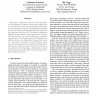Free Online Productivity Tools
i2Speak
i2Symbol
i2OCR
iTex2Img
iWeb2Print
iWeb2Shot
i2Type
iPdf2Split
iPdf2Merge
i2Bopomofo
i2Arabic
i2Style
i2Image
i2PDF
iLatex2Rtf
Sci2ools
CVPR
2005
IEEE
2005
IEEE
Hierarchical Part-Based Visual Object Categorization
We propose a generative model that codes the geometry and appearance of generic visual object categories as a loose hierarchy of parts, with probabilistic spatial relations linking parts to subparts, soft assignment of subparts to parts, and scale invariant keypoint based local features at the lowest level of the hierarchy. The method is designed to efficiently handle categories containing hundreds of redundant local features, such as those returned by current keypoint detectors. This robustness allows it to outperform constellation style models, despite their stronger spatial models. The model is initialized by robust bottom-up voting over location-scale pyramids, and optimized by ExpectationMaximization. Training is rapid, and objects do not need to be marked in the training images. Experiments on several popular datasets show the method's ability to capture complex natural object classes.
Computer Vision | Current Keypoint Detectors | CVPR 2005 | Probabilistic Spatial Relations | Scale Invariant Keypoint | Stronger Spatial Models | Visual Object Categories |
| Added | 12 Oct 2009 |
| Updated | 12 Oct 2009 |
| Type | Conference |
| Year | 2005 |
| Where | CVPR |
| Authors | Guillaume Bouchard, Bill Triggs |
Comments (0)

